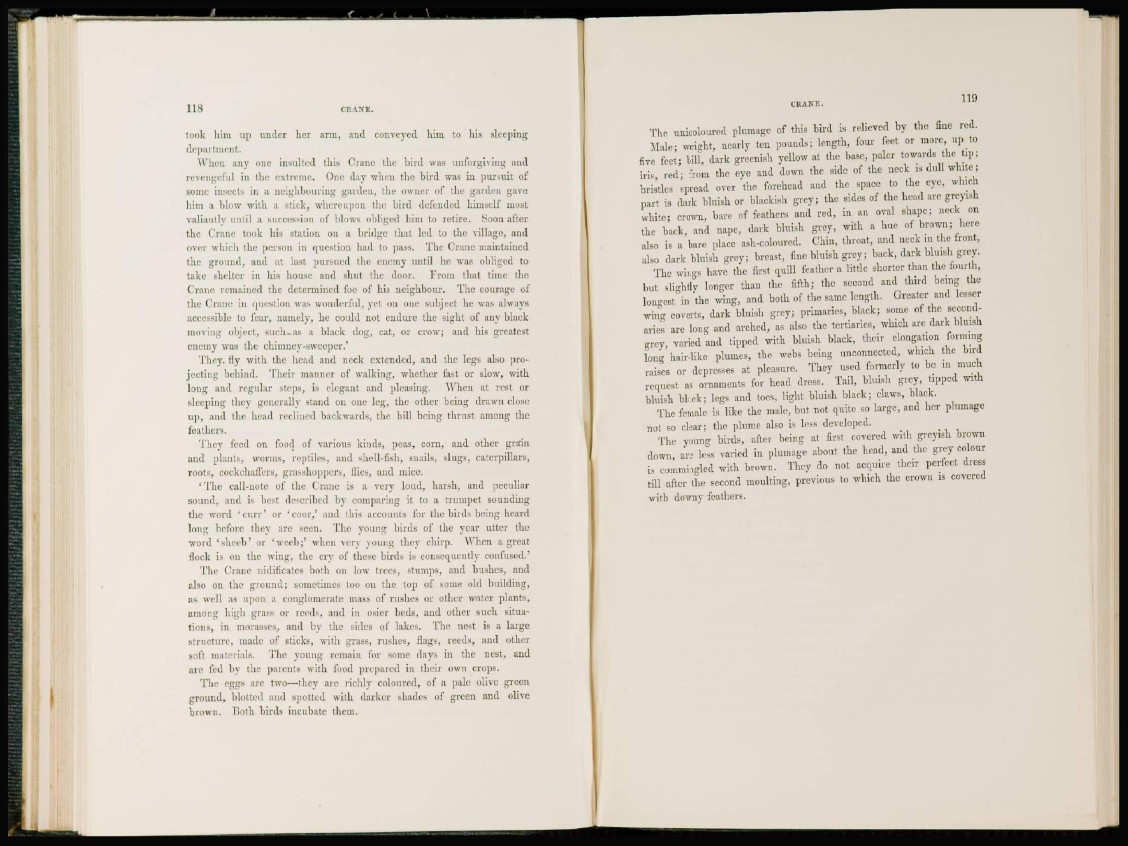
took him up under her arm, and conveyed him to his sleeping
department.
When any one insulted this Crane the bird was unforgiving and
revengeful in the extreme. One day when the bird was in pursuit of
some insects in a neighbouring garden, the owner of the garden gave
him a blow with a stick, whereupon the bird defended himself most
valiantly until a succession of blows obliged him to retire. Soon after
the Crane took his station on a bridge that led to the village, and
over which the person in question had to pass. The Crane maintained
the ground, and at last pursued the enemy until he was obliged to
take shelter in his house and shut the door. From that time the
Crane remained the determined foe of his neighbour. The courage of
the Crane in question was wonderful, yet on one subject he was always
accessible to fear, namely, he could not endure the sight of any black
moving object, such-as a black dog, cat, or crow; and his greatest
enemy was the chimney-sweeper.'
They, fly with the head and neck extended, and the legs also projecting
behind. Their manner of walking, whether fast or slow, with
long and regular steps, is elegant and pleasing. When at rest or
sleeping they generally stand on one leg, the other being drawn close
up, and the head reclined backwards, the bill being thrust among the
feathers.
They feed on food of various kinds, peas, corn, and other grain
and plants, worms, reptiles, and shell-fish, snails, slugs, caterpillars,
roots, cockchaffcrs, grasshoppers, Hies, and mice.
' T h e call-note of the Crane is a very loud, harsh, and peculiar
sound, and is best described by comparing it to a trumpet sounding
the word ' e u r r ' or 'coor,' and this accounts for the birds being heard
long before they are seen. The young birds of the year utter the
word ' s h e e b ' or Sveeb;' when very young they chirp. When a great
flock is on the wing, the cry of these birds is consequently confused.'
The Crane nidificates both on low trees, stumps, and bushes, and
also on the ground; sometimes too on the top of some old building,
as well as upon a conglomerate mass of rushes or other water plants,
among high grase or reeds, and in osier beds, and other such situations,
in morasses, and by the sides of lakes. The nest is a large
structure, made of sticks, with grass, rushes, flags, reeds, and other
soft materials. The young remain for some days in the nest, and
are fed by the parents with food prepared in their own crops.
The eggs are two—they are richly coloured, of a pale olive green
ground, blotted and spotted with darker shades of green and olive
brown. Both birds incubate them.
The unicoloured plumage of this bird is relieved by the fine red.
Male; weight, nearly ten pounds; length, four feet or more, up to
five feet; bill, dark greenish yellow at the base, paler towards the tip;
iris, red; from the eye and down the side of the neck is dull white;
bristles spread over the forehead and the space to the eye, which
part is dark bluish or blackish grey; the sides of the head are greyish
white; crown, bare of feathers and red, in an oval shape; neck on
the back, and nape, dark bluish grey, with a hue of brown; here
also is a bare place ash-coloured. Chin, throat, and neck in the front,
also dark bluish grey; breast, fine bluish grey; back, dark bluish grey.
The wings have the first quill feather a little shorter than the fourth,
but slightly longer than the fifth; the second and third being the
longest in the wing, and both of the same length. Greater and lesser
wing coverts, dark bluish grey; primaries, black; some of the secondaries
are long and arched, as also the tcrtiaries, which are dark bluish
grey, varied and tipped with bluish black, their elongation forming
long hair-like plumes, the webs being unconnected, which the bird
raises or depresses at pleasure. They used formerly to be in much
request as ornaments for head dress. Tail, bluish grey, tipped with
bluish bhirk; legs and toes, light bluish black; claws, black.
The female is like the male, but not quite so large, and her plumage
not so clear; the plume also is less developed.
The young birds, after being at first covered with greyish brown
down, are less varied in plumage about the head, and the grey colour
is commingled with brown. They do not acquire their perfect dress
till after the second moulting, previous to which the crown is covered
with downy feathers.